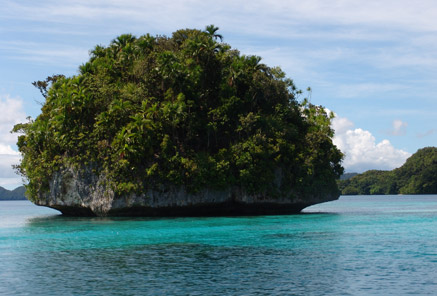Republic of Palau
Geography
Land Use
People
Economy
Water Statistics
|

Status of Water Resources
Palau produces 300 billion gallons (1.1 billion cubic metres) of water per year from surface water run-off. The island of Babeldaob has 5 major watersheds with an additional 11 minor watersheds. The Ngerikiil River in Airai supplies 3 million gallons (11,000 cubic metres) a day to the Koror/Airai Water Treatment Plant for use by three-fourths of the population of Palau. The rest of the islands of Palau rely on groundwater sources and rainfall.
Problems with Water Resources and Associated Environment Issues
- Extent to which groundwater and surface water resources exploited
The Ngerimel Dam decreased water flow into the lower part of its watershed, but the flora and fauna of that area have acclimated to the decreased water levels over the past decades.
- Use of Alternative Sources
Almost every household has some sort of rainwater catchment system, ranging from simple plastic lined 55-gallon steel barrels to imported aluminium 400 gallon tanks to constructed cement tanks. Desalination has been raised in the past though never thoroughly explored. Store bought water bottles are a popular alternative drinking water source.
- The various and relative demands placed on watersheds/water resources
Watersheds are heavily relied upon as water sources. The Koror/Airai treatment plant estimates extraction of 4.5 million gallons per day from the Ngerimel Dam and Ngerikiil River, based on amount processed within the plant, not actual amount of intake. However with an expected migration to Babeldaob, increased water usages from the rural public water systems are expected.
- Competing uses of water and priority uses
Competing uses on the water supply comes from the tourism industry, which diverts hundreds of thousands of gallons. Mangroves and coral reefs are dependent on certain level of freshwater. How water extraction is impacting the coastal environment and the extent to which impounding water has on decreasing fresh water flow to coral reefs is unknown at this time.
- Sources of pollution of surface water, groundwater and coastal waters
The main source of pollution is sedimentation caused by poor erosion controls, loss of riparian buffers, and poor landuse practices. Pollution into the groundwater sources is from poorly maintained septic tanks, leachate from nearby landfills, etc and also from saltwater intrusion. On the platforms and atolls, there is a need to limit the amount of water extracted per day. Coastal waters are impacted daily from land-based pollution, gasoline and oil from outboard motors and ships. With more development expected on the larger islands, other sources of pollution will be inevitable, i.e. sewage, chemical pollution, oil spill, etc.
Diagnostic Report
Demonstration Proposal
Hot Spot Analysis
Information on this page obtained from Integrated Water Resources Management programme's Diagnostic Reports (SOPAC 2007)
© 2024 SPC Water, Sanitation and Hygiene. All rights reserved.